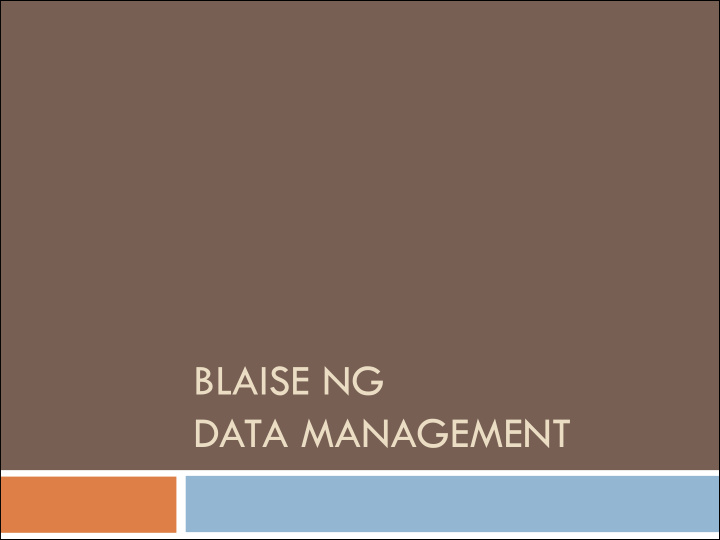



BLAISE NG DATA MANAGEMENT
Phase 1 CTP: Data access Use of 4.x data files BDB’s BOI support only if Blaise 4.8 installed Access to data files exclusively through Blaise NG API service and Blaise 4.8 API service
Phase1(CTP) : Database access Blaise NG Blaise 4.8 Blaise NG BDB DEP API Service API Service
Phase 2: Data access Replace the 4.x Blaise database (BDB) files Add support for most popular relational databases Be compatible with the 4.x search capabilities Implement trigram keys Add lookup functionality Change the data access process Phase out data access through the 4.8 API Service Use Blaise Data Provider for .NET instead
Phase2: Database access Blaise Blaise NG Blaise NG Data Data DEP Provider Service for .NET RDBMS
Ingredients to make this work
The Blaise NG Database Extension BDBX Default data storage option in NG Relational database format; SQLite based Lightweight SQL database Open source; C++ code is available Transactional, zero-administration, serverless, self- contained Unicode support; Multi-platform SQLite .NET Data Provider Demo: Automatic creation of required data files by running the DEP
Blaise Data Interface files Extension BDIX Main data file in Blaise NG; not the BDBX Uses the same concepts as a BOI file Contains logical information; no data ConnectionString Database specific connection string Data Provider and Data Source information Table definitions and their structure Data Model information
Blaise Data Interface files Supported providers and drivers .NET Framework Data Providers Managed providers .NET Framework Data Provider for SQL Server Oracle Data Provider for .NET Preferred and most direct way to connect OLE DB Data Providers Access through Microsoft .NET Data Provider for OLE DB Microsoft Jet OLE DB Provider ODBC drivers Access through Microsoft .NET Data Provider for ODBC MySQL Connector ODBC
Blaise Data Interface files Initially supported data sources Blaise database files (*.bdbx) Microsoft SQL Server Microsoft Access (*.mdb; *.accdb) Oracle MySQL SQLite Text files Demo: Create a data interface based on an existing database table
Blaise NG Data Storage We plan to include the following storage features Non-generic / generic storage Several storage structures Stream Type specific data columns Meta and data versioning Special versioning columns can be added optionally DataModelKey BeginStamp and EndStamp Demo: Create a data interface and Blaise database file via Wizard
What’s in the background
Components Overview Blaise Data Data Supported Blaise SQL Provider Access Parser Databases for .NET Layer Oracle BlaiseConnection Classes for Abstract Data SQL Server BlaiseCommand Access Builds Abstract MS Access Syntax Tree for a BlaiseDataReader Blaise SQL statement SQLite BlaiseDataAdapter Object Oriented MySQL SQL Statement Builder SQLComposer (Not … Public)
Blaise Data Provider for .NET Used by Blaise client applications to access data Implements required .NET Data Provider interfaces Can be used in order to access Blaise database files (bdbx) Relational databases ‘Talks’ Blaise SQL SQL using Blaise syntax rules and reserved words
Blaise Data Provider for .NET objects BlaiseConnection Opens connection to a data source ConnectionString typically contains the data interface file to open BlaiseCommand Executes command against the data souce BlaiseDataReader Fast forward readonly cursor BlaiseDataAdapter Fills and updates data sets
Using Blaise Data Provider for .NET
Blaise SQL examples
Blaise SQL Parser Blaise SQL will be parsed by the Blaise SQL Parser ANTLR based Result of the parsing process is a statement dependent Abstract Syntax Tree SQLComposer reads the AST and builds a database specific SQL statement By using the Data Access Layer (DAL) By taking into account Table structures and storage structure as defined in bdix The native SQL syntax of the database
Data Access Layer (DAL) Interacts with the data source Builds data source’s native SQL Client apps of DAL uses abstract base classes ConnectionBase SelectStatementBase UpdateStatementBase ... OO approach for building SQL statements
Data Access Layer (DAL)
Recommend
More recommend